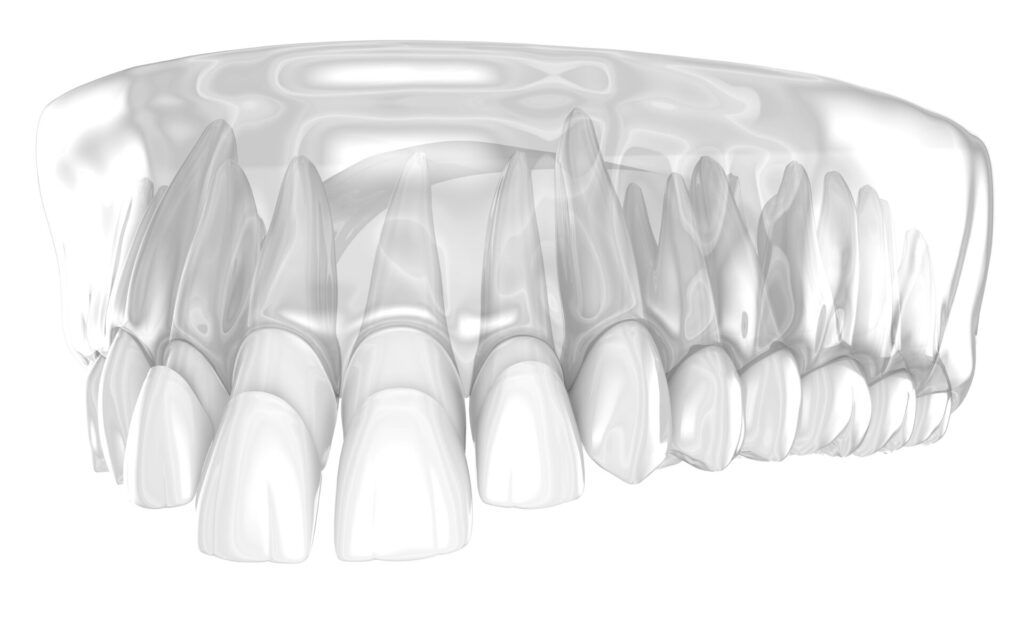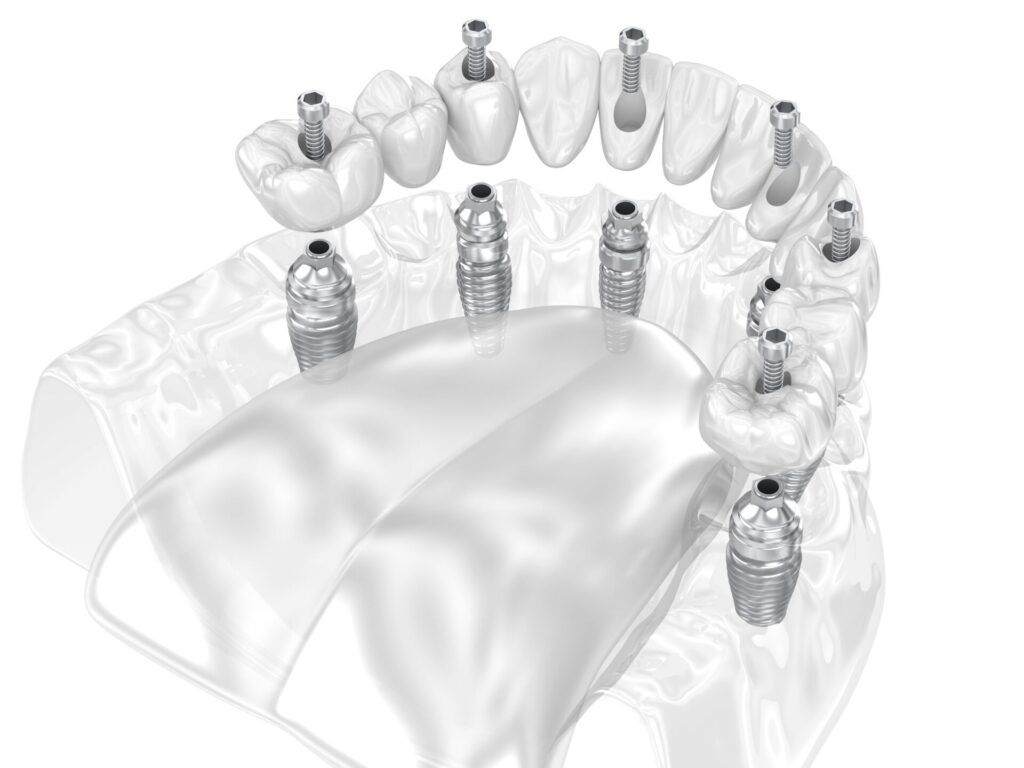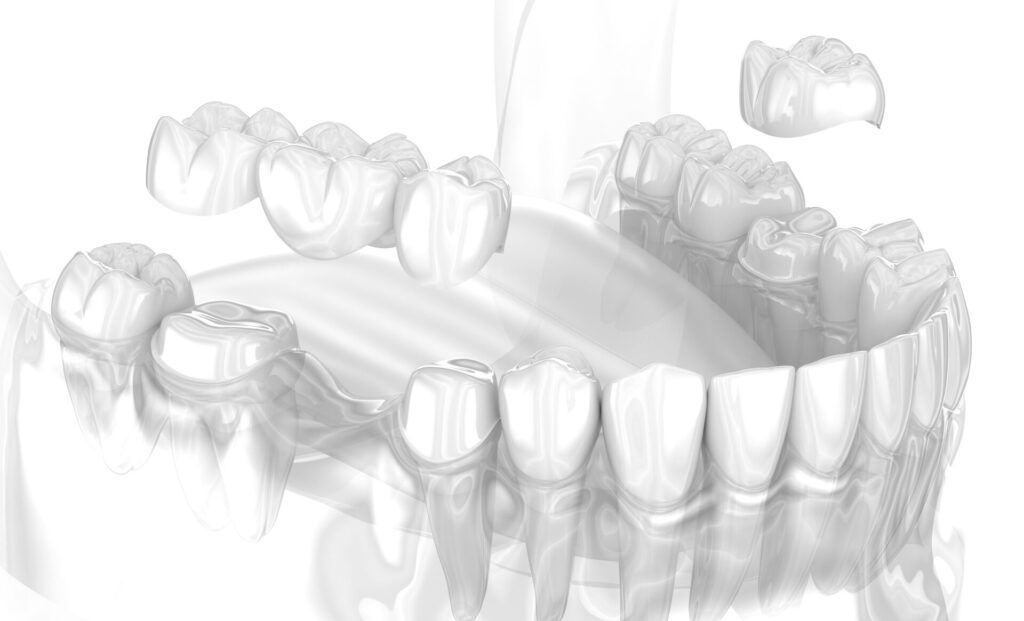
Dental prosthetics

Prosthetics
Dental prosthetics is a medical sector that helps functionally and aesthetically renovate a loss tooth or its part.
Dental prosthetics can be divided in two departments:
- Removable dental restorations;
- Irremovable dental restorations (tooth crowns, bridges, veneers and root inlays).
Dental crowns
Crown of artificial material
A crown of artificial material is an artificial coating (‘a cap’) that is used when a tooth has lost more than 50% of its crown part. A dental crown restores the natural size, shape, and functions of the tooth as well as strengthens and protects the rest tissues of the tooth.
According to the needed load, aesthetical requirements, and the economic abilities the following types of dental crowns can be produced:
Crowns of metallic alloy
Crowns are made of metal; they feature metallic gloss and they are very endurable, but due to their pure aesthetics they are usually applied in the lateral area of the mouth.
They can be made of gold as well.
Crowns of plastic and composite
Plastic crowns are used as long-term temporary crowns. They are of the same colour as the tooth still they are not durable; they split, discolour and also cannot bear much of load. The average term of use is two years.
Metal ceramic crowns
The metal ceramic crowns have a metal base that is covered with an aesthetic ceramic coating. Metal ceramic crowns are the most often used dental crowns of artificial coating as they are highly endurable and they aesthetically resemble the natural teeth. They are used both for the incisive and the lateral teeth. They are also used for bridged restorations. Golden ceramics crown can be made as well.
Zirconium crowns
Zirconium crowns are electronically cut of aluminium or zirconium oxide and they are highly endurable against load as well as featuring a good aesthetics as they are made of white material. They feature the natural transparency of teeth; therefore the material is used both for the front and the back teeth. Bridged restorations are also possible.
Ceramic crowns
Crowns are made of pressed ceramics that is the most aesthetical of the materials as transparency comparable to the one of a natural tooth can be reached. However, it has lower load persistence so these crowns are suggested for use on the front teeth.
Procedure description
- Once the patient and the dentist have agreed upon the appropriate treatment, the treatment process is started.
- If needed, anaesthesia is applied.
- An imprint is made to produce a temporary crown.
- A tooth gets grinded by the special tools to make application of a temporary crown of appropriate thickness and later the true dental crown possible.
- Once the tooth has been grinded, an imprint and also the occlusion register are developed. A temporary crown with temporary cement is placed.
- During the following visits first the crown base, then also the completed crown is to be fitted. The crown is fitted in occlusion and all the needed corrections are made. If the colour and shape fits, the crown is to be sent back to the laboratory in order to be enamelled.
- At the last visit the crown gets fixed with special cement.
Dental bridges
According to the needed load, aesthetical requirements, and the economic abilities the following types of dental bridges can be produced:
Artificial coating bridge
A dental bridge of artificial coating is a type of dental prosthetics where one or two (seldom three) missing teeth are replaced if on both sides of the defect there are support teeth.
Bridge of metallic alloy
A bridge of metallic alloy is made of metal, it features metallic gloss and it is highly endurable. Due to its pure aesthetics it is used for the lateral teeth and may be combined with metal ceramic dental crowns.
Plastic and composite bridge
A plastic dental bridge is used as a long-term temporary bridge. It is not load durable.
Metal ceramic bridge
A metal ceramic bridge has a metal base that is covered with an aesthetical ceramic coating. A metal ceramic bridge is the most often used type of artificial coating dental bridges as it features high durability and aesthetically it resembles natural teeth. It is used both for front and back teeth.
Zirconium bridge
A zirconium bridge is electronically of aluminium or zirconium oxide and it is highly endurable against load as well as featuring a good aesthetics as it is made of white material. It features the natural transparency of teeth; therefore the material is used both for the front and the back teeth.
Procedure description
- Once the patient and the dentist have agreed upon the appropriate treatment, the treatment process is started.
- If needed, anaesthesia is applied.
- An imprint is made to produce a temporary bridge.
- The support teeth get grinded by the special tools to make application of a temporary bridge of appropriate thickness and later the true dental bridge possible.
- Once the tooth has been grinded, an imprint and also the occlusion register are developed. A temporary bridge with temporary cement is placed.
- During the following visits first the bridge base, then also the completed bridge is to be fitted. The bridge is fitted in occlusion and all the needed corrections are made. If the colour and shape fits, the bridge is to be sent back to the laboratory in order to be enamelled.
- At the last visit the bridge gets fixed with special cement.
Recommendation!
- In order to make a dental bridge, two support teeth are to be grinded. Make sure whether a dental implant would not result in better treatment of the defected area.
- A dental bridge needs special care, so do not forget to floss it with a special floss threader for flossing under the dental bridges as well as schedule regular visits to the hygienist.
Root inlays
In case a tooth has lost most of its crown tissue it needs a root inlay to be put in. A root inlay is placed in the dental root and a crown of artificial coating is to be cemented upon it.
A root inlay can be made both of metal (if metal ceramic crowns are used) and zirconium (for no-metal crowns). These do not differ functionally but aesthetically – when applying no-metal crowns, a metallic inlay may show through.
Procedure description
- A root inlay is paced in a tooth that has received endodontic treatment, shows no sign of inflammation and the crown part of which has been lost so that the tooth can be restored by application of a root inlay.
- The crown part of the tooth gets prepared for a root inlay as well as the endodontic filling gets partially removed from the root part of the tooth. The dentist shapes a plastic sample of the inlay that is to be moulded or cut of zirconium at the laboratory. A temporary crown is applied to the tooth.
- In the following session the inlay is to be fixed with special cement and a new temporary crown is made.
- The tooth is prepared for further prosthetics.
Dental veneers

Porcelain plates or veneers are used in order to improve the aesthetics of the incisive teeth for instance to treat dental discolouring, to even the dental row or to strengthen the teeth.
The porcelain plates are from 0.2 to 2 mm thick, so just a little gets grinded from the natural tooth and the tooth does not lose its functionality and durability.
If the teeth are carefully maintained and protected (from bruxism for example), the average term of service for veneers is 10 years.
Procedure description
- At the first visit an imprint is taken so that temporary plates may be made. In the laboratory a wax-up with a sample of future porcelain plates is made.
- During the following visit the teeth get grinded and temporary veneers are made of special plastic.
- An imprint for the true porcelain veneers is taken.
- At the first fitting session the base of the plates is adjusted, at the following time the veneers are to be fitted to ensure their colour are shape are correct and they fit the occlusion.
- If everything concords the requirements, the plates are fixed with special cement.
Removable dental restorations

Removable dental restorations are used in case of partial or complete loss of teeth. Removable prosthetics are used when they may not be replaced with irremovable dental restorations as well as a temporary solution before the implants have been placed. Dental prosthetics are financially more accessible than irremovable dental restoration and it is also a simpler prosthetics method as it does not involve any invasive interference in the oral tissue.
Removable metal base denture
A removable metal base denture is used in cases when the patient has support teeth preserved than can carry the denture. The denture is grounded on the tooth with bearings and anti-rotation is ensured by metallic embraces that are place along the gums. In order to avoid in-aesthetical solutions, the holding elements of the denture can be imbedded in the dental crowns of artificial coating. The metal base is thin, which allows the patient getting used to the restoration more successfully, and it is more stable than a plastic removable denture.
An implant supported removable denture
Implants ensure complete fixture of a denture as it is supported by a special attachment system. Fixture is so good that a denture can be shaped with smaller base margins, which eases getting used to the denture, also speaking and eating. Implant fixture is used both at partial and total dental loss. A denture is easy to maintain and use; its good fixture significantly improves the quality of the patient’s life.
Removable plastic base denture
A removable plastic base denture is used in cases when one tooth is missing as well as in cases of total dental loss. Plastic dentures are divided:
- Partial plastic denture in case of partial dental loss;
- Total denture in case of total dental loss.
Partial dentures are grounded on the soft tissues of the oral cavity, and ant-rotation and fixture is provided by metallic embraces along the rim of the gum. The base of plastic dentures is thicker and bigger than a metal base denture so it takes more time to get used to it.
A total plastic denture is used if all the teeth of the respective jaw are missing. A correctly shaped total denture is made with maximum base margins to optimally ensure fixture of the base. Fixture of a total upper denture is weaker therefore more than seldom it must be fixed with denture glue. The best solution for maximum denture fixture is a removable denture that is supported by implants.
Procedure description
- When the patient and the dentist have agreed upon the most appropriate method, the treatment process is started. The first imprint is to be taken. If the patient has lost the lateral teeth, the laboratory uses the first imprint to make a special individual imprint spoon so that the true imprint can be taken with maximum precision.
- During the following visit the height of occlusion is determined by a laboratory-made wax preparation so that the respective denture fit the height of the patient’s occlusion. The colour of the new denture is also determined during this visit. The wax try-in is to be sent to the dental laboratory. In case a metal denture is to be made, the metallic base is adjusted at this time.
- During the following visit the teeth that have been placed in a wax try-in are fitted to the patient. The patient can visually assess the appearance and the size of the denture and its compliance with the occlusion.
- If the previous visits have been successful, the new denture is handed to the patient.
Recommendation!
- Once the removable denture has been handed to the patient it happens that it weighs on the soft tissue of the oral cavity. It is absolutely normal as the oral mucous membrane is not used to such a burden. In such a case you should bay all means contact your dentist and schedule for the denture correction.
- The denture should be kept clean but it should not be excessively rubbed – it must not be rubbed by sharp brushes or abrasive pastes. Using special tablets for marinating the denture clean is the best option.
- The patient should not forget also to take care of the existing teeth and the oral mucous membrane.
Night splint

Nowadays a term of bruxism is becoming more widespread. Bruxism or teeth grinding is contractions of chewing muscles which results in grinding the teeth against each other with quite a force. Teeth grinding often happens at night still it is widespread also during the daytime when one is highly concentrating for instance when working at the computer or during a physical load.
What does it do to our teeth?
The teeth are wearing out; the occlusion key – an eye tooth – gets worn out first and then gradually also the surface of other teeth gets uneven until total deterioration has developed over entire occlusion – the teeth have lost their vertical height, they have shortened.
People mostly do not feel and do not notice this as the process is gradual, so both the joint and the muscles adjust to the new height of the teeth. It often happens that the patients do not believe it when told they have bruxism, but teeth grinding takes place during sleep or while concentrating at some other activity therefore it goes unnoticed.
As the reason of teeth grinding is found in the activity of the central nervous system, there is no medicine available to prevent it. However, we can prevent further wear of the teeth – the people who suffer from bruxism should use a night splint every night. It is an individually shaped rubber splint that is placed on the bottom (more seldom the upper) teeth in order to amortise the mutual contact of the teeth so that they do not touch each other and stop wearing out.
Procedure description
- An imprint of the patient’s teeth is taken and sent to the laboratory for producing a night splint.
- During the following visit the patient is given a night splint and advised to use it every night.
Prices
Prosthetics
Metal ceramic crown
Ceramic crown
Zirconium crown
Porcelain veneer
Protective, whitening and night splint
After filling out the form, we will contact you within 1 working day and specify the appointment time.
We will contact you within 1 working day.





